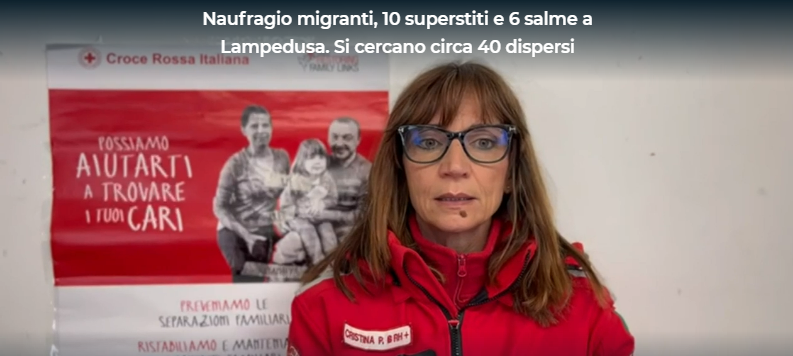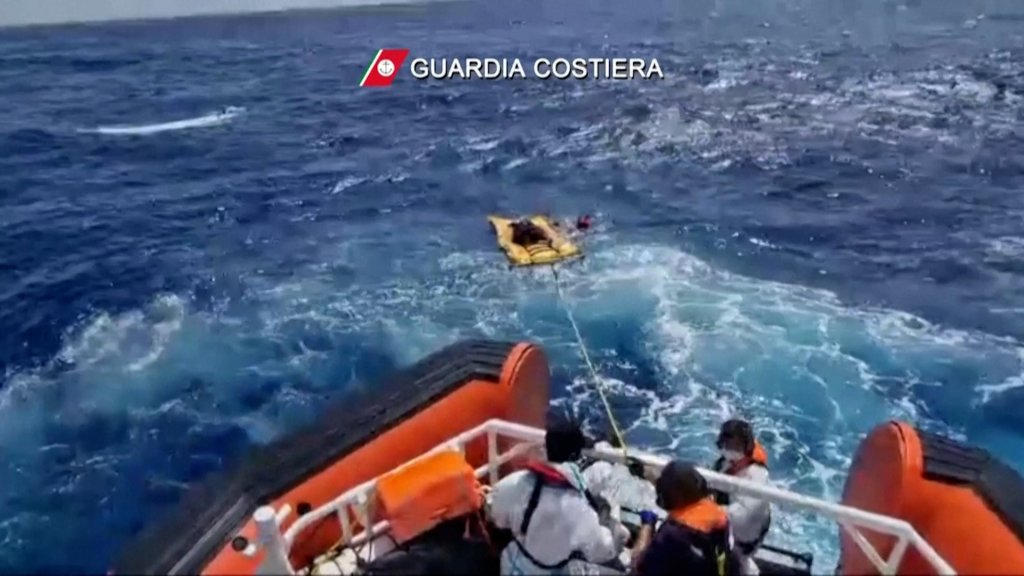The latest shipwreck in the Central Mediterranean occurred east of the Italian island of Lampione on Tuesday. Just ten people survived, six bodies were found and around 40 are believed to still be missing, including children. The incident comes amid an increase in the number of arrivals on this route once again.
The Italian Coast Guard released a press statement on Wednesday afternoon (March 19), confirming that the search and rescue operations around the area of the shipwreck were continuing, but that because of the bad weather in the area, and the proximity to the island Lampione, a smaller island west of Lampedusa, much of the search was being conducted from helicopters and planes in the air. Frontex was helping in the search, reported the news agency Associated Press (AP).
"The migrants were on board an inflatable boat that was, when we arrived, in a precarious state and barely afloat," stated the Italian Coast Guard in a press release. The survivors told Italian police that one by one people fell into the sea, because of the stormy waves and the sinking ship. "We weren’t able to save them," remember the survivors, reported the Italian news agency ANSA.
Around 56 migrants are believed to have been traveling on board the boat, which departed from the Tunisian port of Sfax, so around 40 are still believed to be missing. UNICEF, the United Nations agency for children, believes that children are among those missing. The incident is the second one this week in which multiple migrants died or are still missing. Survivors say those on board came originally from Cameroon, Ivory Coast, Mali and Guinea (Conakry).
Read AlsoItaly: Migrant sea arrivals decrease slightly in February
Survivors in tears and in shock
One of the survivors, reported ANSA, told police in tears that this wife had been among the first people to fall into the water. She was not one of the six bodies already recovered, added the news agency. Italian prosecutors have opened an investigation into the incident.
The boat began deflating a few hours into the voyage, stated the UN refugee agency UNHCR. Another survivor, a young teenager from Cameroon told the Italian left-leaning newspaper Il Manifesto that they lost their younger brother, who was just 12 years old in the shipwreck. This young man said they had tried to call for help, but no one had arrived in time.
Francesca Saccomandi from the organization Mediterranea Hope, a project supported by the Federation of Protestan Waldesian churches in Italy, told Il Manifesto they had been told by the survivors they had been at sea for five days. Mediterranea Hope provides assistance to migrants as they arrive on Lampedusa.
Saccomandi added that the migrants had told her team that the situation was "so violent in Tunisia at the moment, and the number of departures had been so reduced," that they didn’t feel they had a choice when to jump on a boat. One young man reportedly spent 11 months in Tunisia with thousands of other migrants before being able to board a boat. The young man was "in a state of shock," on arrival, reported Il Manifesto, "with a swollen arm and evident difficulties walking."
Read AlsoMigrants rescued from gas platform off Tunisia
Psychological support
The ten survivors, including four women, were taken to the so-called 'hotspot' or first reception center on the Sicilian satellite island of Lampedusa on Tuesday (March 18). The center's vice director Cristina Palma told the Italian state broadcaster Rai: "They (the survivors) have had a good night’s sleep and they are all in good health, luckily."
"We will be offering them further psychological help from our multidisciplinary team," she added.

Arrivals in Italy
According to data from the Italian Interior Ministry, 8,936 migrants have arrived in Italy since the beginning of the year. The figures were last updated early on March 20. This is a slight increase based on the equivalent period in 2024, when 8,879 people arrived, but a significant reduction compared to the same period in 2023, when 20,364 migrants arrived.
On March 19, the Italian Interior Ministry recorded 26 arrivals by small boat, compared to 213 on March 18, and 231 on March 17. According to the Italian government, most arrivals are from Bangladesh, followed by Pakistani nationals. Syrians and Egyptians follow after that and then Eritrean and Sudanese nationals.
The government is keen to point out that, over the past year, arrivals have decreased by about 60 percent compared to 2023, the first year after it took office. Prime Minister Giorgia Meloni attributes this reduction in part to the bilateral deals the country has signed with its southern Mediterranean neighbors, like Libya and Tunisia.
Read AlsoItaly: 'Drop in irregular arrivals thanks to our efforts,' says Meloni
Frontex data shows increases on the central Mediterranean route
Data from the European border agency Frontex for February 2025, showed that in the first two months of 2025, the central Mediterranean route, towards Italy, was defying the overall trend of a drop in the number of attempts at crossing into the EU.
According to Frontex, "the number of irregular border crossings into the European Union dropped by 25 percent in the first two months of 2025, to nearly 25,000. While most routes saw a decrease in the number of arrivals, the central Mediterranean route defied the trend."
Frontex said that rise represented a 48 percent increase in year-on-year arrivals. The top nationalities detected attempting to cross into the EU were listed as Afghan, Bangladeshi and Malian.
However, when asked to clarify this figure, which appears to show a different direction of travel than the Italian data, Frontex spokesperson Krzysztof Borowski replied in an email to InfoMigrants: "When looking at the preliminary data, including early March, the year-on-year change in arrivals becomes much smaller. This is why we always advise against drawing firm conclusions based on just a couple of months of data. Winter weather plays a major role in crossings, often leading to significant fluctuations."
Borowski added that arrivals in the Mediterranean "can shift due to a mix of factors, including sea conditions and enforcement measures along the route. Early 2024 saw relatively low arrivals, which makes the increase in January and February this year look more dramatic."
'Smugglers are always looking for the path of least resistance'
Frontex deemed the central Mediterranean route to be the second most active route into the EU in January and February this year. Libya has resumed its place as the primary departure point for this route. Frontex says that smugglers are "increasingly relying on powerful speedboats to outmaneuver authorities." According to Frontex, a crossing on this route can cost between 5,000 and 8,000 euros per person. The Bangladeshi nationals traveling on this route generally fly to Libya with work visas before then embarking on a sea crossing, states the agency.
Borowski underlined that while the central Mediterranean route was apparently becoming more active, the Western African route across the Atlantic to the Canary Islands, with 7,200 arrivals in January and February, was still the most active. Borowski said that "smuggling networks are constantly adapting to changing enforcement measures, border policies, and conditions at sea. When controls tighten on one route, crossings may increase elsewhere."
The border agency spokesperson explained that "migration routes don't exist in isolation. When pressure builds in one area, it often shifts to another. Smugglers are always looking for the path of least resistance."
Borowski added that in Frontex' experience, migration itself is also influenced by many factors "beyond political agreements. Developments on the ground, economic pressures, security conditions, and smuggler tactics all play a role." The spokesperson said the agency was "closely monitoring the situation to understand what is driving these movements."
Arrivals from Bangladesh
InfoMigrants asked Borowski whether the agency had any data about why the numbers of nationals from Bangladesh towards Italy may have increased in the last few years. Borowski answered by email: "Over the past few years, we have seen a recurring pattern where the number of Bangladeshi nationals arriving via Libya peaks at the start of the year, before tapering off later. Many initially travel to Libya legally under labor agreements, with some arriving through a formal memorandum of understanding signed between Libya and Bangladesh in late 2023."
"Once in Libya, some migrants lose their jobs, face exploitation, or find themselves in unsafe conditions, leading them to turn to smugglers for the next leg of their journey. For others, the plan from the start is to continue on ward to Europe. Smugglers are quick to exploit these situations, using pathways and gaps in enforcement to facilitate crossings."
Frontex said they were not able to share information about how many migrants might be waiting to cross from Libya and Tunisia at the moment. InfoMigrants also reached out to the Bangladeshi embassy in Libya for more data, but has not yet received a reply.
Borowski did say that the numbers of who might be in North Africa are "highly fluid and depend on multiple factors, including border enforcement, smuggling activity, and changing conditions on the ground."
"Predicting migration numbers is not an exact science. People move when conditions allow, and smugglers exploit every opportunity."
Read AlsoItaly: More than 120,000 migrants passed through Lampedusa since 2023

Refugees and asylum seekers in Libya
UNHCR estimates there are about 82,305 refugees in western Libya, around 2,985 in the east and around 11, 264 in the south, although more of these, the agency states are internally displaced people from Libya itself. As a comparison, at the end of 2024, UNHCR said they estimated there were about 277,000 refugees and asylum seekers in Libya.
This figure had dropped to about 85,930 on March 1 this year. The majority of the registered refugees and asylum seekers come from Sudan, accounting for around 74.7 percent of the total refugee and asylum-seeking population in the country. Eritreans are the next largest national group, accounting for just over ten percent (10.2 percent) and people from Syria at nine percent.
In February, around 60 percent of the refugees and asylum seekers in Libya were male and around 40 percent female, according to UNHCR. Around 28 percent of these people had no educational background, around 19 percent had a university education, around 48.2 percent said they had completed high school and around 31.9 percent had been to primary school.
UNHCR data from the adult population showed that around 38,823 had had no occupation, or it was unknown in their country of origin. Around 8,146 had worked in the services sector, and around 2,771 in construction or trade professions, and around 2,060 in agriculture, forestry and farming. The majority of the registered refugees and asylum seekers are living in the Libyan capital Tripoli.
Read AlsoItaly: Overall migrant landings drop amid rise in Bangladeshi arrivals

Arrivals in Italy and deaths at sea
In the last four days, around 600 migrants have arrived in Italy by small boat, and private rescue organizations also picked up migrants in the Central Mediterranean. On Wednesday (March 19), the ship crew of the rescue ship Aurora picked up 26 migrants, originally from Bangladesh, Sudan, Syria, Nigeria and Egypt, reported ANSA.
The organization Save the Children said that in just over a decade since 2014, more than 31,500 people had died in the Mediterranean, including more than 1,300 minors. "We should never get used to these deaths," said Giorgia D’Errico, Director of Institutional Relations for the organization.
